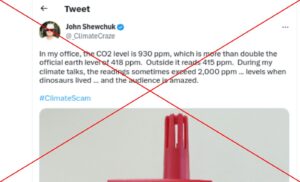Physical Address
23,24,25 & 26, 2nd Floor, Software Technology Park India, Opp: Garware Stadium,MIDC, Chikalthana, Aurangabad, Maharashtra – 431001 India
Physical Address
23,24,25 & 26, 2nd Floor, Software Technology Park India, Opp: Garware Stadium,MIDC, Chikalthana, Aurangabad, Maharashtra – 431001 India

CLAIM
Variation in CO2 levels between indoor and outdoor spaces proves climate change is a scam.
FACT
It is normal to have higher CO2 concentration levels indoors and it cannot be compared to the global average level of CO2 in the atmosphere which is increasing at an unprecedented rate leading to global warming.
Claim Post:
WHAT DOES THE CLAIM SAY
A Twitter post on March 10, 2023, posted a photo of a portable ‘Amprobe’ CO2 meter. It cited various CO2 levels recorded indoors and outdoors and compared them with 418 ppm, a number close to the recent global average of CO2. The post implied that recording much higher figures indoors compared to the global average of CO2 concentration proves climate change is a scam.
The shown model Amprobe CO2-100 is a handheld carbon dioxide meter used for checking indoor air quality. It can measure carbon dioxide up to 9999 ppm.
WHAT WE FOUND
According to a study, carbon dioxide concentrations below 1000 ppm in indoor air quality conditions are acceptable. Usually, carbon dioxide is not found in hazardous levels in the indoor environment. Even in the open environment, carbon dioxide levels typically range from 300 to 400 ppm (0.03% to 0.04%) but can be as high as 600-900 ppm in metropolitan areas.
Also, around 200 million years ago, during the Jurassic era, it is estimated that the Earth’s carbon dioxide level reached 2000-6000 ppm. However, this data cannot be compared with the CO2 levels of closed space in the current scenario. The current average carbon dioxide level of the Earth is around 420 ppm which is not even close to the dinosaur era. However, if we look at the geological time scale, we would find that CO2 levels are comparatively low, but according to experts, greenhouse gases like carbon dioxide are increasing at an unprecedented rate and a similar spike in the past has resulted in mass extinctions.
How are carbon dioxide levels measured?
In our atmosphere, carbon dioxide gas is well mixed. That is, around the world, its concentration is more or less consistent. However, if we measure too close to any significant source of carbon dioxide like a forest fire, a factory emitting gases, or the gasoline-burning cars around a city, the recorded levels would be high. Due to this reason, scientists constantly measure the average level of CO2 in the Earth’s atmosphere by taking air samples at various remote locations around the world, including at the top of an active volcano.
Satellites use spectroscopic principles but on a grander scale. Such satellite measurements improve the overall picture of Earth’s atmosphere. For example, NASA’s Orbiting Carbon Observatory (OCO-2) satellite can track the carbon sources within a particular region.
Why is there a difference between carbon dioxide levels recorded indoors and outdoors?
Indoor areas have a confined space and CO2 levels are usually higher due to the exhaled carbon dioxide by the building occupants (for example, humans, pets, etc.). Human metabolism alone can lead to CO2 levels in excess of 3,000 ppm, especially in poorly ventilated rooms. Other ways contributing to higher carbon dioxide levels in indoor areas are the cooking appliances- particularly the gas stove.
The reason for the high level of carbon dioxide during a climate talk
A ‘climate talk’ or any similar event usually takes place in a closed indoor environment. In the case of a closed indoor space, the level of CO2 depends upon the following:
Carbon dioxide concentrations indoors can vary from several hundred ppm to thousands in areas with many people present for an extended period and when the ventilation is limited. The higher the number of occupants in an indoor environment, the higher will be the concentration of CO2 in indoor air.
What level of CO2 in indoor air is alarming?
CO2 is a crucial determinant of indoor air quality. As the carbon dioxide concentration increases with an increase in the number of people in an indoor environment, it is safe to presume that the concentration of CO2 is in sync with the presence of humans and ventilation. This is because carbon dioxide can accumulate in the lack of proper ventilation as it is exhaled by humans and can dilute and eliminate the indoor concentration of the other gases.
This table shows varying concentrations of CO2 in indoor air:
| Carbon dioxide levels in parts per million | Effects |
| 250-350 ppm | Normal outdoor air level |
| 350-1,000 ppm | Typical level in occupied spaces with adequate air exchange |
| 1,000-2,000 ppm | Complaints of drowsiness and unbreathable air |
| 2,000-5,000 ppm | Headaches, drowsiness, and stagnant, stale, stuffy air; difficulty in concentration, loss of attention, increased heart rate, and slight nausea may also be present. |
| >5,000 ppm | Toxicity or oxygen deprivation (asphyxia) could occur. It is the permissible exposure limit for daily workplace exposures. |
| >40,000 ppm | This level is immediately harmful/ dangerous to life due to oxygen deprivation. |
The emission of carbon dioxide from various human activities like the burning of fossil fuels is ultimately increasing the amount of carbon dioxide naturally available in the atmosphere. Rising levels of carbon dioxide have a direct impact on climate change.
As of 2016, CO2 accounted for about 74.4 percent of total greenhouse gas emissions.
The IPCC’s major climate science report in 2021 states that CO2’s contribution to the heat change process was more than 60 percent from 1960 to 2019.
Thus, rising carbon dioxide levels in the atmosphere are a serious cause of concern.
References: